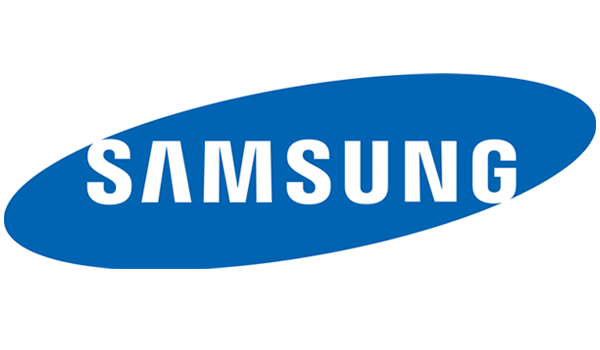Samsung’s Wi-Fi solution incorporates relevant components from the latest LTE mobile communications technology, to deliver unparalleled performance for no-compromise wireless working.
With the increasing popularity of mobile devices in the enterprise, such as smartphones and tablets, demands on the WLAN are growing more complex due to the number of separate devices competing for service on the move.
The Samsung WLAN solution uses the industry standard IEEE802.11 a, b/g, n and ac whilst incorporating technology adopted from the recent Samsung investment in LTE, to address the specific needs of voice and video without impacting data throughput.
Seamless automatic handover when moving between Access Points (APs) removes the burden on devices and risk of disruption, while the application of Crystal HD Voice ensures the best possible speech quality and wireless service regardless of the type or number of devices in use.
The Samsung APs deliver on design as well as performance. Using multi-antenna technology, the typical range is increased by 14% whilst speech quality and data errors are improved by 30%. In addition, the superior power of the APs also affects the devices connected to them, minimising their own power consumption for longer battery life, and increases the number of concurrent users per AP by up to 50% compared with competitive products.
Key Benefits

Air Equaliser
Samsung’s Traffic Schedule technology ensures a fully optimised Wi-Fi service by allocating equal airtime to multiple devices. This technology guarantees airtime fairness when multiple devices are concurrently connected to an AP. It also delivers seamless service, even in an environment where devices with different traffic demands and capabilities are used. In addition, it can maximise the AP’s total throughput by more than 50% when compared with competitors’ products, providing the best performance that adapts to the Wi-Fi connection specifications(a, b/g, n, ac) and signal intensity characteristics.
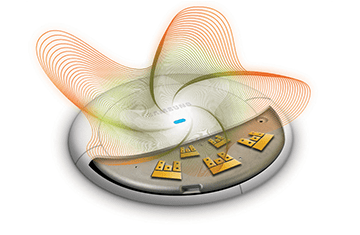
Intelligent Beam
A Samsung 3 x 3 AP contains 14 antennas. Two antennas are used for RF monitoring and the remaining 12 provide an optimised RF pattern selecting a beam for each environment. As a result, dead areas are minimised, service coverage is expanded, and the receiving sensitivity is 2 dB higher than competitors’ products. This means that the access point can accurately receive a signal from a mobile device with typically weak transmit power even when it is some distance away.

Air Move*
Samsung AirMove technology applies the handover methodology used within LTE mobile communications to deliver seamless roaming. Timing and choice of access point is determined centrally by the Access Point Controller (APC) which has a full picture of device activity and adjacent AP loading.
*requires additional elements
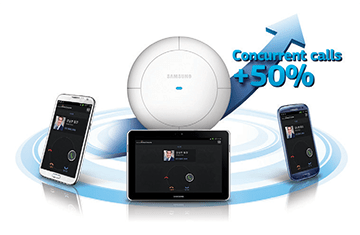
Voice Aware Traffic Scheduling
VaTS is a Samsung patented technology, which efficiently sends Voice Frames to multiple devices using mobile communication traffic scheduling technology developed for LTE networks. The result is that increasing the number of concurrent calls will not degrade voice quality, increasing the effective capacity of the network.
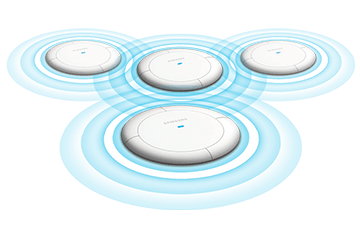
Self Organising Network
Samsung have enhanced the standard Wi-Fi access point Tx power and channel optimisation technology using techniques developed for the LTE network. This technology automatically optimises the cell configuration and coverage, considering individual device characteristics within the environment. This dramatically shortens the time required for network design, reducing implementation costs, and also delivers a high level of RF quality management when the network is in use.
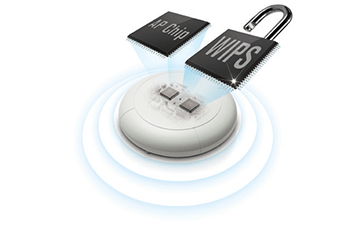
Wireless Intrusion Prevention
The importance of security in the enterprise communication environment cannot be over emphasised. The Samsung APs have a dedicated security RF monitoring chip embedded, which is separate to the Wi-Fi service RF chip, to enable continuous real-time monitoring of the local RF environment. This maximises the RF sensing performance without impacting on Wi-Fi data throughput as there is no need to utilise a Wi-Fi data time slot, or any increase to the system cost by adding additional monitor APs.
